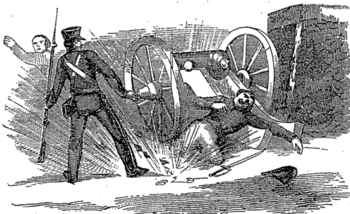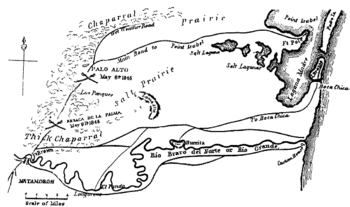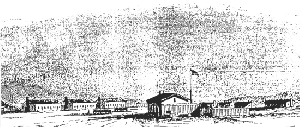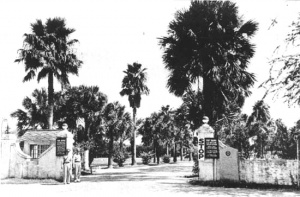Fort Brown (1)
|
Fort Brown (1846-1948) - A U.S. Army Fort established in 1846 just before the Mexican War at present-day Brownsville, Houston County, Texas. Named for Major Jacob Brown who was killed at Fort Brown (then Fort Texas (1)) in 1846. Fort Brown served during the Mexican War, the U.S. Civil War, World War I and World War II. Also known as Fort Taylor (1) and Fort Texas (1). Mexican War (1846-1848)In 1845, when Mexican officials rejected U.S. President James K. Polk's offer to buy western lands, he ordered U.S. troops into the disputed region between Texas and Mexico increasing the likelihood that Mexican troops would cross the Rio Grande and strike the first blows. In March 1846 General Zachary Taylor's army of 3,000 crossed the Nueces River and marched south. The army stopped at a bluff beside a bend in the river, directly across from Matamoros and began construction of a fort. Seeing the U.S. soldiers, many of the 20,000 Matamoros residents fled, leaving behind about 4,000 civilians and the Mexican army. Fort Texas (1), as it was first named, was an earthen structure with walls 15 feet wide shaped into a six-sided star. The finished walls stood nine to 10 feet tall. Chief engineer Captain Joseph K.F. Mansfield followed a plan calling for hollowing out a ditch about eight feet deep and 15 to 22 feet wide, creating another defense around the fort perimeter. A drawbridge spanned the ditch, and a gate was placed at the entrance. The fort projected out to form palisades at each of the star's six points where soldiers placed cannons facing every approach, including Mexican gun emplacements on the opposite side of the Rio Grande. The provocation came as a U.S. patrol led by Captain Seth Thornton was ambushed by Mexican troops under General Anastasio Torrejon and the President asked Congress for a declaration of war which was quickly passed by both houses. Mexican forces began a siege of the incomplete fort on 3 May 1846 bombarding the fort with artillery. The U.S. artillery replied with great effect. Lieutenant Braxton Bragg (Cullum 895), who later became a Confederate general, directed the U.S. artillery that fired on Ampudia’s troops. Maj. Jacob Brown was killed in one of the artillery exchanges and the Fort was later named for him. Fifteen soldiers in the Fort Texas siege were later Civil War generals, including George H. Thomas, John Reynolds (Cullum 1084), Lafayette McLaws (Cullum 1158), Ulysses S. Grant, D.C. Buell (Cullum 1090), George G. Meade (Cullum 804), Braxton Bragg, T.H. Holmes (Cullum 584), James Longstreet (Cullum 1164), J.C. Pemberton(Cullum 917) and E. Kirby Smith (Cullum 1255). In the late 1850's Robert E. Lee served here. Taylor had previously set out for Fort Polk (1) at Point Isabel to strengthen its defenses after several days began a return march to relieve the siege at Fort Texas. Returning, he was obliged to fight his way back at the battle of Palo Alto on 8 May 1846. Upon his return to Fort Texas, he learned of Maj. Jacob Brown's death and renamed the Fort after him. Taylor's forces moved on to Mexico and eventually ended the Mexican war by capturing Mexico City on 14 Sep 1847. Fort Brown served as a supply post and way station for the Mexican expedition but saw no further action. General Zachary Taylor became a legend while occupying Fort Brown and gained the nickname of "Old Rough and Ready". U.S. Civil War (1861-1865)After the Mexican War, U.S. troops built a new Fort Brown about a half-mile north of the original bastion, beside the Rio Grande. Soldiers in the late 1840s and the 1850s occasionally rode out on patrols to hunt cattle thieves and bandits. The new frontier post, built primarily from wood scavenged from the Point Isabel supply depot, was decidedly rustic. The wood buildings met strong disapproval from the Army inspector general who complained in 1854 that wood was inferior to brick. Deadly diseases were a constant threat at Fort Brown in the 1850s. In fact, almost every officer died from illness in 1853. Foul drinking water from the Rio Grande was a leading cause of sickness because the river was the polluted repository of human and animal wastes upstream. At the start of the U.S. Civil War, Texas state officials demanded that federal troops abandon Fort Brown and leave all supplies for the Confederacy. U.S. Army Captain B.H. Hill (Cullum 911) complied with the request to leave but destroyed many supplies. Confederates took control of the fort and remained there for a time. In November 1863, U.S. General Nathaniel P. Banks launched an invasion toward Brownsville from Brazos Santiago Island on the Gulf of Mexico coast. Hearing of the Union approach, Confederate General H.P. Bee ordered Fort Brown's evacuation. Confederate soldiers set fire to the fort and dozens of bales of cotton as they left. Fort Brown's fire spread to downtown Brownsville, leaping from one building to the next as smoke and panic engulfed the town a massive explosion destroyed most of Fort Brown. Law and order departed with the army and looting began. Union troops occupied what was left of Fort Brown and began rebuilding it. The fort became the Union staging ground for raids against wagon trains carrying cotton toward Mexico. In July 1864 Confederates once again took possession of Fort Brown and remained until the war ended with Fort Brown in very poor condition. Post WarBy 1867, fort rebuilding began in earnest, but the project had barely started when a powerful hurricane, one of the worst on record, struck the coast in October, leaving horrible devastation. Fort Brown was once again in shambles. Most of the new buildings only recently completed were leveled by the powerful winds. Rebuilding began yet again. Construction over the next 12 years led to between 40 and 70 new buildings, including seven officers quarters, a headquarters building, and a hospital said to have been the most beautiful hospital on any U.S. Army post. By 1910 Fort Brown was virtually deserted but unrest in Mexico caused troops once again to garrison Fort Brown. Fort Brown was also important during both World Wars. During the activation of forces for World War II, the 12th U.S. Cavalry was transferred from Fort Brown and replaced by the 124th Cavalry of the Texas National Guard, which was the last cavalry unit in the nation to give up their horses and also the last regiment housed at Fort Brown. The 124th left to fight in Burma in the Far East, leaving behind only a few soldiers at Fort Brown, which was soon deactivated. Fort Brown was deactivated in 1945 and 162 acres was deeded to the City of Brownsville on 22 Jul 1948.
Current StatusMost of the remaining buildings and land belong to the University of Texas-Pan American at Brownsville and Texas Southmost College.
Sources:
Links: Visited: No
| |||||||



